| Listing 1 - 10 of 29 | << page >> |
Sort by
|
Book
ISBN: 1631173650 9781631173653 1631173642 9781631173646 Year: 2014 Publisher: New York
Abstract | Keywords | Export | Availability | Bookmark
 Loading...
Loading...Choose an application
- Reference Manager
- EndNote
- RefWorks (Direct export to RefWorks)
Pay equity. --- Comparable worth --- Equal pay for comparable work --- Equal pay for work of comparable value --- Equity, Pay --- Worth, Comparable --- Wages
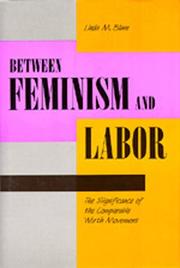
ISBN: 0520910834 0585313156 0520072596 0520070321 0520354672 Year: 1991 Publisher: Berkeley : University of California Press,
Abstract | Keywords | Export | Availability | Bookmark
 Loading...
Loading...Choose an application
- Reference Manager
- EndNote
- RefWorks (Direct export to RefWorks)
Equal pay for equal work has long been a forceful slogan of the feminist and labor movements. Now, however, as the American economy depends more and more on "women's work," it has become clear that this objective does not benefit the majority of women, who are employed in sex-segregated jobs. In Between Feminism and Labor, Linda M. Blum examines the movement for comparable worth, or equal pay for comparable work, as a strategy to raise wages for the "pink-collar" jobs that are most frequently occupied by women. She explores the larger political implications of the movement and provides the first study of pay equity to focus directly on the mobilization of the female work force at the grass-roots level.Through two case studies of local comparable worth movements—in San Jose and Contra Costa County, California—Blum probes several important issues. She asks whether comparable worth can contribute to the formation of active labor-feminist alliances, and after a nuanced, intelligent analysis of the complexities and contradictions of comparable worth, endorses its radical potential to improve women's wages and forge links between gender- and class-based politics.Between Feminism and Labor also situates comparable worth in the context of the limitations of affirmative action, a strategy seeking to move women into male jobs as opposed to raising the value of women's work. It is the first study to contrast these two strategies and to place them within the theoretical and political debates over the validation of gender difference versus the requirement of gender neutrality. As such, the book should stimulate debate among those concerned with the future of the feminist movement, as well as those interested in the future of organized labor and progressive politics in America.
Pay equity --- Feminism --- Business & Economics --- Labor & Workers' Economics --- Case studies. --- Case studies --- Comparable worth --- Equal pay for comparable work --- Equal pay for work of comparable value --- Equity, Pay --- Worth, Comparable --- Wages
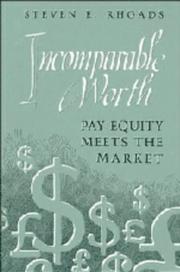
ISBN: 0521441870 0521478286 0511571674 9780521441872 9780511571671 9780521478281 Year: 1993 Publisher: Cambridge Cambridge University Press
Abstract | Keywords | Export | Availability | Bookmark
 Loading...
Loading...Choose an application
- Reference Manager
- EndNote
- RefWorks (Direct export to RefWorks)
Comparable worth, or pay equity, is now an established policy in some US states, such as Minnesota, and the UK and Australia. Yet Steven Rhoads's research on those jurisdictions indicates there is no consensus on how to compare the value of dissimilar jobs involving 'comparable' amounts of effort, skill and responsibility. Consultants whose job evaluation systems are used in states adopting comparable worth policies do not agree on the factors to be included or how they should be weighed and arbitrary results produced by comparable worth policies have led to inefficient functioning of the labour markets. These policies have generated ill will among the workers who lose pay-equity cases, with political as well as economic consequences. The book argues that jobs are truly incomparable using the methods comparable worth relies on, and that the principles of comparable worth are not reconcilable with those of a market economy.
Wages --- United States --- Oceania with Australia --- Pay equity --- Minnesota (Etat) --- Australia --- Social Sciences --- Political Science --- Pay equity - Minnesota. --- Pay equity - Australia. --- Comparable worth --- Equal pay for comparable work --- Equal pay for work of comparable value --- Equity, Pay --- Worth, Comparable --- United States of America
Book
ISBN: 9789264267534 Year: 2016 Publisher: Paris : OECD Publishing,
Abstract | Keywords | Export | Availability | Bookmark
 Loading...
Loading...Choose an application
- Reference Manager
- EndNote
- RefWorks (Direct export to RefWorks)
Le Programme international de l’OCDE pour le suivi des acquis des élèves (PISA) cherche non seulement à évaluer ce que les élèves savent en sciences, en compréhension de l’écrit et en mathématiques, mais aussi à déterminer ce qu’ils sont capables de faire avec ces connaissances. Les résultats de l’enquête PISA révèlent la qualité et l’équité de l’apprentissage dans le monde entier, et offrent aux professionnels de l’éducation et aux responsables politiques la possibilité de découvrir les politiques et pratiques d’autres pays et de s’en inspirer. Vous avez entre les mains l’un des cinq volumes qui présentent les résultats de l’évaluation PISA 2015, la sixième édition de cette enquête triennale. Le volume I, L’excellence et l’équité dans l’éducation, résume la performance des élèves en sciences, en compréhension de l’écrit et en mathématiques, et définit et mesure l’équité dans l’éducation. Il se concentre sur les attitudes des élèves à l’égard de l’apprentissage en sciences et analyse leur aspiration à embrasser une carrière scientifique. Il examine aussi l’évolution de la performance et de l’équité ces dernières années dans les pays et économies participant à l’enquête PISA. Le volume II, Politiques et pratiques pour des établissements performants, examine les liens entre la performance des élèves et diverses caractéristiques des établissements et des systèmes d’éducation, notamment les ressources affectées à l’éducation, l’environnement d’apprentissage et les critères de sélection des élèves entre les établissements, les filières d’enseignement et les classes. Le volume III, Le bien-être des élèves, décrit la relation entre les résultats scolaires des élèves de 15 ans et leur vie sociale et leurs attitudes à l’égard de l’apprentissage. Le volume IV, La culture financière des élèves, analyse les connaissances et l’expérience des élèves dans les matières financières. Le volume V, La résolution collaborative de problèmes, analyse la capacité des élèves à travailler à plusieurs pour la résolution de problèmes. Il examine aussi le rôle de l’éducation dans le développement de la capacité des jeunes à résoudre des problèmes en équipe.
Education --- Pay equity --- Comparable worth --- Equal pay for comparable work --- Equal pay for work of comparable value --- Equity, Pay --- Worth, Comparable --- Wages --- Children --- Education, Primitive --- Education of children --- Human resource development --- Instruction --- Pedagogy --- Schooling --- Students --- Youth --- Civilization --- Learning and scholarship --- Mental discipline --- Schools --- Teaching --- Training --- Education. --- Pay equity.
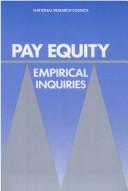
ISBN: 0309039789 9786610214655 1280214651 0309542979 0585143927 9780585143927 0309039819 9780309039819 9781280214653 6610214654 9780309542975 9780309039789 Year: 1989 Publisher: Washington, D.C. National Academy Press
Abstract | Keywords | Export | Availability | Bookmark
 Loading...
Loading...Choose an application
- Reference Manager
- EndNote
- RefWorks (Direct export to RefWorks)
Pay equity --- Congresses. --- Wages. --- Compensation --- Departmental salaries --- Earnings --- Pay --- Remuneration --- Salaries --- Wage-fund --- Wage rates --- Working class --- Comparable worth --- Equal pay for comparable work --- Equal pay for work of comparable value --- Equity, Pay --- Worth, Comparable --- Wages --- Income --- Labor costs --- Compensation management --- Cost and standard of living --- Prices --- E-books
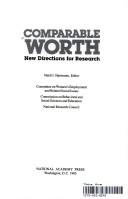
ISBN: 0309035341 9786610222292 1280222298 0309573599 058514284X 9780585142845 9780309035347 0309076684 9780309076685 Year: 1985 Publisher: Washington, D.C. National Academy Press
Abstract | Keywords | Export | Availability | Bookmark
 Loading...
Loading...Choose an application
- Reference Manager
- EndNote
- RefWorks (Direct export to RefWorks)
Pay equity --- Wages --- Research --- Compensation --- Departmental salaries --- Earnings --- Pay --- Remuneration --- Salaries --- Wage-fund --- Wage rates --- Working class --- Comparable worth --- Equal pay for comparable work --- Equal pay for work of comparable value --- Equity, Pay --- Worth, Comparable --- Income --- Labor costs --- Compensation management --- Cost and standard of living --- Prices --- E-books
Book
ISBN: 303051031X 3030510301 Year: 2021 Publisher: Cham, Switzerland : Springer,
Abstract | Keywords | Export | Availability | Bookmark
 Loading...
Loading...Choose an application
- Reference Manager
- EndNote
- RefWorks (Direct export to RefWorks)
Women now represent over half of medical school matriculants, almost half of residents and fellows, and over a third of practicing physicians nationally. Despite considerable representation among the physician workforce, women are paid 75 cents on the dollar compared with their male counterparts after accounting for specialty, geography, time in practice, and average hours per week worked. This pay gap is significantly greater than the one reported for US women workers as a whole and has shown little improvement over time. While much has been written about the problem, a robust discussion about how to rectify the situation has been missing from the conversation. Closing the Gender Pay Gap in Medicine is the first comprehensive assessment of how cultural expectations and compensation methodologies in medicine work together to perpetuate salary disparities between men and women physicians. Since the gender gap reflects a convergence of forces within our healthcare enterprises, achieving pay equity can be an overwhelming undertaking for institutions and their leaders. However, compensation is foremost a business endeavor. Therefore, a roadmap for operationalizing equity within the finance, human resources, and compliance structures of our organizations is critical to eliminating disparities. The roadmap described in this book breaks down the component parts of compensation methodology to reveal their unintentional impact on salary equity and lays out processes and procedures that support new approaches to generate fair and equitable outcomes. Additionally, the roadmap is anchored in change management principles that address institutional culture and provide momentum toward salary equity. The book begins with a review of the evidence on the gender pay gap in medicine. The following chapter discusses how gender-based differences in performance assessments, specialty choice, domestic responsibilities, negotiation, professional resources, sponsorship, and clinical productivity accumulate across women’s careers in medicine and impact evaluation, promotion, and therefore compensation in the healthcare workplace. The next two chapters focus, respectively, on how compensation is determined - highlighting potential pitfalls for pay equity - and regulatory and legal considerations. Chapters 5 and 6 explore organizational infrastructure, salary data collection and analysis, and culture change strategies necessary to rectify compensation inequities. Chapter 7 offers a detailed account of one medical institution’s successful journey to achieve salary equity. The book’s final chapter emphasizes that closing the gender pay gap is at its essence a business endeavor and recommends that organizations assess progress and cost with the same attention, rigor, and regularity as afforded other operating expenses. Closing the Gender Pay Gap in Medicine offers a detailed roadmap for healthcare organizations seeking to close the gender pay gap among their physician workforce. This first-of-its-kind book will assist institutions plan courses of action and identify potential pitfalls so they can be understood and mitigated. It will also prove a valuable resource for transformational leadership and systems-based change critical to attaining compensation equity.
General practice (Medicine). --- Health administration. --- General Practice / Family Medicine. --- Health Administration. --- Pay equity. --- Wages --- Salaries and Fringe Benefits. --- Women. --- Women --- Women employees --- Comparable worth --- Equal pay for comparable work --- Equal pay for work of comparable value --- Equity, Pay --- Worth, Comparable --- Salaries, etc.
Book
ISBN: 9789222269334 9222269330 9789222269327 Year: 2013 Publisher: Geneva, Switzerland
Abstract | Keywords | Export | Availability | Bookmark
 Loading...
Loading...Choose an application
- Reference Manager
- EndNote
- RefWorks (Direct export to RefWorks)
Discrimination in employment --- Pay equity --- Comparable worth --- Equal pay for comparable work --- Equal pay for work of comparable value --- Equity, Pay --- Worth, Comparable --- Wages --- Bias, Job --- Employment discrimination --- Equal employment opportunity --- Equal opportunity in employment --- Fair employment practice --- Job bias --- Job discrimination --- Race discrimination in employment --- Employment (Economic theory) --- Affirmative action programs --- Law and legislation
Book
ISBN: 0197628184 0197628176 0197628192 Year: 2023 Publisher: New York, NY : Oxford University Press,
Abstract | Keywords | Export | Availability | Bookmark
 Loading...
Loading...Choose an application
- Reference Manager
- EndNote
- RefWorks (Direct export to RefWorks)
Pay equity has become a hot topic recently with pay transparency viewed as an important way to narrow gender and racial pay gaps. This book offers evidence-based insights into how pay policies and practices impact outcomes at individual, organisational, and societal levels. Without taking a position one way or another, this volume presents the good and the bad of pay transparency. Most importantly, it presents a reader friendly summary of the evidence demonstrating when and for what outcomes pay transparency may be beneficial, or alternatively, detrimental, thus providing policy makers, managers, and HR specialists with the basis for making evidence-informed decision.
Wages. --- Equal pay for equal work. --- Pay equity. --- Discrimination in employment --- Wages --- Women --- Compensation --- Departmental salaries --- Earnings --- Pay --- Remuneration --- Salaries --- Wage-fund --- Wage rates --- Working class --- Income --- Labor costs --- Compensation management --- Cost and standard of living --- Prices --- Comparable worth --- Equal pay for comparable work --- Equal pay for work of comparable value --- Equity, Pay --- Worth, Comparable --- Employment --- Industry. --- Economics.
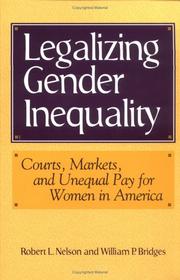
ISBN: 0521627508 0521621690 0511019602 0511173032 0511151985 051132328X 0511499345 1280432209 0511050410 9780511019609 9780521621694 9780511499340 9786610432202 6610432201 9780521627504 1107114829 9780521626194 0521626196 0511087810 Year: 1999 Volume: 16 Publisher: Cambridge [England] New York Cambridge University Press
Abstract | Keywords | Export | Availability | Bookmark
 Loading...
Loading...Choose an application
- Reference Manager
- EndNote
- RefWorks (Direct export to RefWorks)
Legalizing Gender Inequality challenges existing theories of gender inequality within economic, sociological, and legal organizations. The book argues that male-female earnings differentials cannot be explained adequately by market forces, principles of efficiency, or society-wide sexism. Rather it suggests that employing organizations tend to disadvantage holders of predominantly female jobs by denying them power in organizational politics and by reproducing male cultural advantages. These findings contradict major legal precedents which have argued that labor markets and not employers are the source of inequality. The authors further argue that comparable worth is an inappropriate remedy, as such an approach misdiagnoses the causes of gender inequality and often falls prey to the same organizational processes that initially generated this differential. The book argues that the courts have, by uncritically accepting the market explanation for male-female wage disparity, tended to legitimate and to legalize a crucial dimension of gender inequality in American society.
Pay equity. --- Pay equity-- Law and legislation-- United States. --- Pay equity --- Labor Law - U.S. --- Law - U.S. --- Law, Politics & Government --- Law and legislation --- Social Sciences --- Sociology --- Comparable worth --- Equal pay for comparable work --- Equal pay for work of comparable value --- Equity, Pay --- Worth, Comparable --- Law --- Wages --- Legal theory and methods. Philosophy of law --- United States --- E-books --- United States of America --- Pay gap --- Legal theory --- Legislation --- Book
| Listing 1 - 10 of 29 | << page >> |
Sort by
|

 Search
Search Feedback
Feedback About UniCat
About UniCat  Help
Help News
News